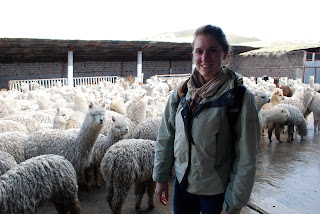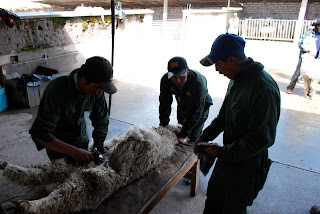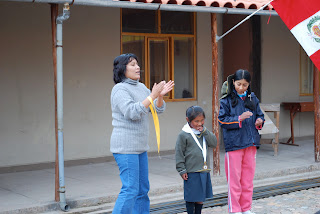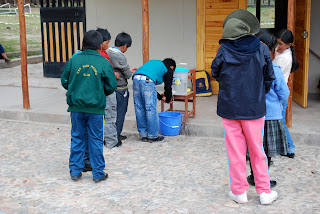Tomorrow, Jesse and I will be presenting our presentation at the Cater Society Society meeting. So, if you're at Washington College, please join us at 7 pm in Goldstein 100. There will be two other fascinating presentations as well!
If you're unable to make it, don't worry!... I have much to share about my trip to the Outstanding Dreams Farm in Preston, MD (including pictures of their beautiful alpacas).
April 9th I had the pleasure of visiting an alpaca farm in Caroline County, MD- roughly an hour drive from the Washington College campus. The owners, Vickie and Phil, are wonderful people! They entered the alpaca industry roughly 4 years ago when they were looking for another income. They liked the idea of an agricultural based lifestyle (Phil is a hay distributor and Vickie has a hair salon). Phil started an internet search looking for an investment when he found information on the alpaca. Before his internet search, he had no idea what an alpaca was!
They started their farm with roughly a $20,000 investment in 3 animals, fencing, barn and other farm needs such as alpaca feed. Today, they have 27 alpacas (8 of which they've sold but are housing until their new owners are read). And best of all, they're profitable! Their business is growing each year. Since September, they sold 15 alpacas. And, last week, they traveled to Michigan to buy 3 more female alpacas.
Alpaca farming in the United States is very different from its Peruvian counterpart. First, the input costs are much higher. Unlike in Peru, the alpacas need to be fed feed to upkeep their diet. Alpacas in the USA should also be registered which includes a blood card with a DNA test. Today, 170,000 alpacas are registered in the USA. To show alpacas they must be registered. Alpaca showing in the USA is largely to advertise your farm and business to other alpaca enthusiasts and to the judge's approval. Champion alpacas' crias sell for much more than a non-champion's cria. And champions also sell for more. Thus, showing your alpacas is almost necessary to be successful. The most expensive alpaca ever sold (a champion hershire) in the USA sold for $675,000 last year!
Another cost and difference is alpacas in the USA are vaccinated. The alpacas on the farm were vaccinated against a parasite carried on the white tail deer which would cause paralysis and death in the alpaca. The alpacas in the farm also have their nails trimmed (by Phil) every 4-6 weeks.
Outstanding Dreams farm earns the majority of their profits from selling alpacas but does have a store. In their store, the majority of the goods were produced from Peruvian alpaca fiber in Peru and exported to the United State because the cost for producing alpaca products in the United States is significantly more. Hand knit alpaca products, such as sweaters, socks and gloves are a popular alpaca fiber commodity. However, the cost of producing such is exponentially less in Peru due to the large supply of alpaca fiber, supply or skilled laborers in handicrafts and inexpensive labor costs. Outstanding Dreams Farm does have some hand knit products fully produced in the United States but due to the high costs of processing the fiber into yarn and the high labor costs for creating the products, the price of the projects are considerably more expensive than their Peruvian counterparts.
Another interesting part of Outstanding Dreams farm business is Agritourism. The farm often hosts tours for daycares, elderly centers and schools as well as private tours. The farm has agreements with multiple bus companies through the county's visitor center. For bus tours, the farm charges $4/person for a brief demonstration and introduction to alpacas but the tourists often just want to shop!
Phil shares with his tours 3 alpaca facts that may make the women in the audience cringe:
1. Alpacas are pregnant for 11-11.5 months.
2. Adult female alpacas weight 150 lbs. and their cria on average weigh 15-20 lbs. when born.
3. Alpacas are only non-pregnant for a few weeks before they're impregnated again.
I bet you're glad you're not a female alpaca right now!
Overall, the experience was wonderful. It was great to meet such wonderful people pursing a very unique lifestyle. If you find yourself in Preston, MD, do stop by... they're wonderful! They have a festival the weekend of September 18th: http://www.outstandingdreamsfarm.com/event/open-house-alpaca-festival.
Beautiful Alpacas at Outstanding Dreams Farm
Alpacas
Phil feeding the alpacas
Snack time
Showing her pearly whites!
All the alpacas are named and thought of as pets.
Beautiful fiber
Quality fleece
Taking a break
Curious animal
The store
Annie (the first cria born on the farm) I bought some yarn from her fiber!



















































